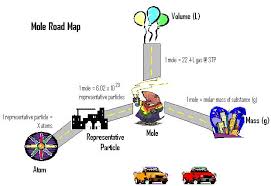Synthesis, Decomposistion, Single Replacement, Double Replacement, Combustion and Neautralization? Don't worry if you forgot we're gonna review them today!
Synthesis:
The combination of two or more substances to form a compound
ex. C + O2 ------> CO2
ex. H2 +Cl2 -----> 2HCl
General Form: A+B----> C
Decomposition:
Is a reaction being able to break down a molecule into a simpler substance
ex. 2AgO + heat ----> 4Ag + O2
ex. 2NO+ heat-----> N2 + O2
General Formula: AB----> A+B
Single Replacement:
A reaction involves replacing one atom in a compound by another atom.
ex. Cu2Cl2 + Fe---> FeCl2 + Cu
ex. Cl2 + 2KI---> I2 + 2KCL
General Formula: A+BC---> B+AC
How to predict Single Replacements:
- If the reacting element is a metal then trade places with the metal atom in the compound
- If the reacting element is non-metal then trade places with the non-metal atom in the compound
Use the Activity Reaction Chart linked below...
Activity Series Chart Link
Lets use an example of a metal : CuI2 + Fe
Remember that the metal switches with the metal, so the Copper (Cu) must switch places with Iron (Fe).
It should look something like this CuI2 + Fe ----> FeI2 + Cu
Let's use anther example of a non-metal: CuI2 + Br2
Remember that the non-metal switches with the non-metal, so Iodine (I) switches with Bromine (Br).
It should look like this CuI2 + Br2 ----> BuBr2 + I2
PRACTICE TIME!!!
1) Cl2 + CaBr2 --->
2) Mg + ZnSO4 --->
3) Al + O2 --->
4) ICl --->
5) Zn +S8 --->
6) Zn + Ni(NO3)2 --->
7) NH3 --->
8) Cl2 + KI --->
9) 3Mg + 2AlCl3 --->
10) 2CrBr3 + 3Zn --->
Answers:
1) Cl2 + CaBr2 ---> Br2 + CaCl2
2) Mg + ZnSO4 ---> Zn + MgSO43) 4Al + 3O2 ---> 2Al2O3
4) 2ICl ---> I2 +Cl2
5) 8Zn +S8 ---> 8ZnS
6) Zn + Ni(NO3)2 ---> Ni +Zn(NO3)2
7) 2NH3 ---> N2 +3H2
8) Cl2 + 2KI ---> 2KCl +I2
9) 3Mg + 2AlCl3 ---> 3MgCl2 + 2Al
10) 2CrBr3 + 3Zn ---> 3ZnBr2 + 2Cr
More practices use these links:
Answers to the practices




